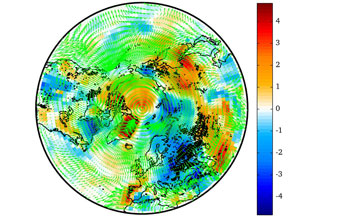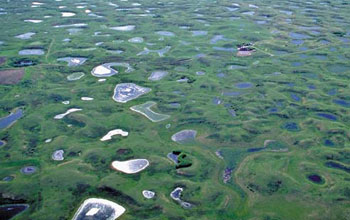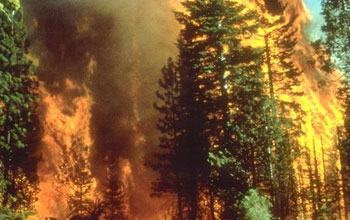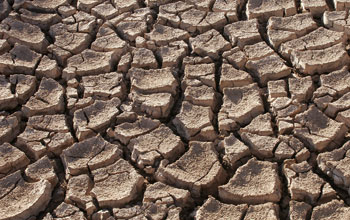Research will lead to better understanding of climate change effects on shorter, more local scales,-
 |
| Simulation of surface temperature changes due to aerosols from Northern Hemisphere fires. Credit: Yongjia Song and Yuhang Wang, Georgia Institute of Technology |
| Download the high-resolution JPG version of the image. (234 KB) |
 |
| EaSM researchers will assess how climate change affects prairie pothole wetlands. Credit: Ducks Unlimited |
| Download the high-resolution JPEG version of the image. (46 KB) |
 |
| Water: more precious than gold. Will there be enough in longer times of drought? Credit: Wikimedia Commons |
| Download the high-resolution JPG version of the image. (113 KB) |
 |
| EaSM grantees will study wildfires and regional climate variability. Credit: Wikimedia Commons |
| Download the high-resolution JPG version of the image. (127 KB) |
 |
| Scorched Earth: drought in the Sonoran Desert cracks open the land. Credit: Wikimedia Commons |
| Download the high-resolution JPG version of the image. (3.7 MB) |
 |
| Hot time in the city: How will climate change affect urban and surrounding areas? Credit: NSF Central Arizona-Phoenix Long-Term Ecological Research Site |
| Download the high-resolution JPG version of the image. (100 KB)
What will Earth's climate be like in a decade--or sooner? And what will it be like where you live, and around the globe?
To help find answers, the National Science Foundation (NSF) and other federal agencies have awarded new grants to study the consequences of climate variability and change.
The awards were made through the interagency Decadal and Regional Climate Prediction Using Earth System Models (EaSM) Program. At NSF, EaSM is part of the Science, Engineering and Education (SEES) portfolio of investments.
"NSF is strongly supportive of the EaSM goal of improved understanding of the climate system," says Roger Wakimoto, NSF assistant director for Geosciences.
"Better climate predictions will arm decision-makers with the quantitative information they need to help chart the appropriate future course for society," says Wakimoto.
Other agencies awarding grants in the interagency EaSM Program are the U.S. Department of Agriculture (USDA) and the U.S. Department of Energy (DOE).
NSF has invested $22.7 million in the awards; USDA, $5.2 million; and DOE, $3.3 million.
Among the subjects addressed by the EaSM awards are:
According to scientists, the EaSM program addresses one of the most pressing problems of the millennium: climate change and how it is likely to affect the world--and how people can plan for its consequences.
That challenge calls for the development of next-generation Earth system models that include coupled and interactive representations of ecosystems, agricultural working lands and forests, urban environments, biogeochemistry, atmospheric chemistry, ocean and atmospheric currents, the water cycle, land and sea ice and human activities.
EaSM projects will expand the limits of scientists' understanding of Earth's climate system, leading to better ways of predicting climate change.
The consequences of climate variability and change are becoming more immediate and profound than anticipated, research has found.
Prolonged droughts on several continents, increasing stresses on natural and managed ecosystems, losses of agricultural and forest productivity, degraded ocean and permafrost habitats, global sea-level rise, the rapid retreat of ice sheets and glaciers, and changes in ocean currents have shown that climate variability and change will likely have significant effects on decade and shorter time scales.
Those effects on humans and other animals, plants, and planet-wide systems such as the oceans, may be far-reaching.
Among the goals of the EaSM program is achieving reliable global and regional predictions of decadal climate variability and change through an understanding of the coupled physical, chemical, biological and human processes that drive the climate system.
Awardees are working to quantify the effects of climate variability and change on ecological, agricultural and other human systems, and to identify and quantify "feedback loops" through which humans affect the environment.
"As climate becomes more variable, precipitation extremes become more frequent and temperatures rise, agricultural producers, foresters and natural resource managers will need to plan and adapt in order to meet the needs of Earth's population," says Sonny Ramaswamy, director of the National Institute of Food and Agriculture at the U.S. Department of Agriculture.
"Understanding the climate system and being able to predict climate trends on decadal and regional scales will be important to helping the agriculture industry remain profitable. These grants will help us move science forward so we can make the best decisions for adaptive management and planning for the future."
Adds Sharlene Weatherwax, DOE associate director for Biological and Environmental Research, "To advance a robust predictive understanding of Earth's climate, and to inform the development of sustainable solutions to our energy and environmental challenges, a deeper understanding of natural climate variability and change is needed.
"The projects DOE supports through EaSM are expected to efficiently enhance the ability to design and deploy the most effective energy solutions for the nation."
Scientists are maximizing observational and model data for impact and vulnerability/resilience assessments, and translating model results and their uncertainties into the scientific basis for well-informed human adaptation to and management decisions for climate change.
These decisions need to happen, say climate researchers, in the coming years--not decades or centuries.
2013 NSF-USDA-DOE EaSM Awards
Gokhan Danabasoglu, UCAR
Jonathan Overpeck, University of Arizona
Richard Seager, Columbia University
Lawrence Buja, UCAR
Collaborative Research: EaSM 2: Stochastic Simulation and Decadal Prediction of Large-Scale Climate:
Dmitri Kondrashov, University of California, Los Angeles
Yuhang Wang, Georgia Tech (jointly funded with DOE)
Brian O'Neill, UCAR
Daniel Cooley, Colorado State University (jointly funded with DOE)
Ray Arritt, Iowa State
Phil Mote, Oregon State University
-NSF-
Media Contacts Cheryl Dybas, NSF (703) 292-7734
Related WebsitesNSF Science, Engineering and Education for Sustainability (SEES) Investment:
http://www.nsf.gov/sees
NSF/EaSM Discovery Article: The Snows of Mount Washington:
http://www.nsf.gov/discoveries/disc_summ.jsp?cntn_id=123363&org=NSF
NSF Publication: Discoveries in Sustainability:
The National Science Foundation (NSF) is an independent federal agency that supports fundamental research and education across all fields of science and engineering. In fiscal year (FY) 2012, its budget was $7.0 billion. NSF funds reach all 50 states through grants to nearly 2,000 colleges, universities and other institutions. Each year, NSF receives about 50,000 competitive requests for funding, and makes about 11,500 new funding awards. NSF also awards about $593 million in professional and service contracts yearly.
Useful NSF Web Sites:
NSF Home Page:
http://www.nsf.gov
NSF News:
http://www.nsf.gov/news/
For the News Media:
http://www.nsf.gov/news/newsroom.jsp
Science and Engineering Statistics:
http://www.nsf.gov/statistics/
Awards Searches: |
The National Science Foundation (NSF).- |
Guillermo Gonzalo Sánchez Achutegui
No hay comentarios:
Publicar un comentario